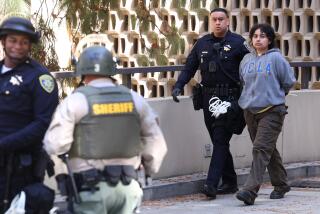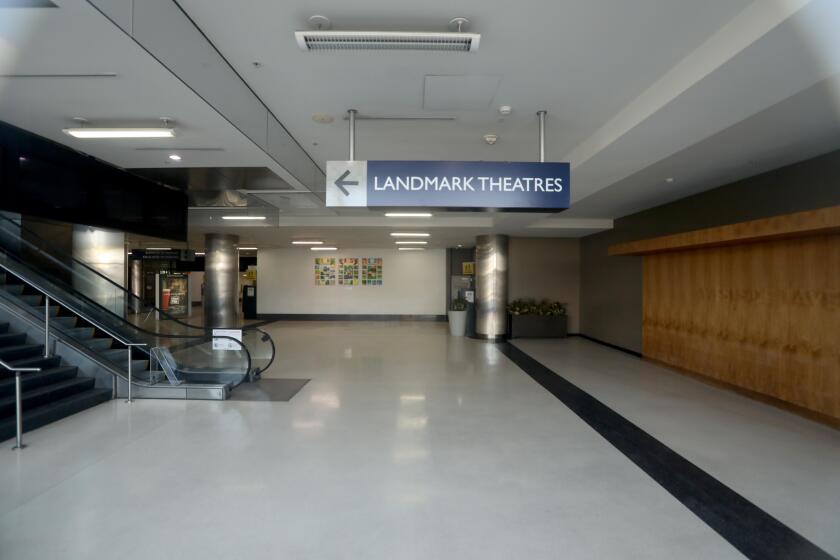Fort Ord’s Happiest Warrior
MONTEREY — The first students were scheduled to arrive in less than a week, and old Fort Ord still looked nothing like a college campus. Hard hats were everywhere--gutting old barracks, pouring concrete, hammering drywall, running telephone lines. Hank Hendrickson was not worried.
The vice president for administration at California’s newest state university sat last Thursday in his corner office--the former base dental clinic--and promised that it would all be lashed together in time. By next Wednesday, Hendrickson said, students would be sleeping in refurbished GI barracks. The old mess hall would be remade into a college cafeteria. Ammo dumps would stand ready to serve as faculty offices.
“It will be ready, period,” Hendrickson said, his blue eyes narrowing, his voice hardening. “The residence hall will be ready. Period. The dining facility will be ready. Period. I spent half of yesterday at the construction site, letting everyone know it will be ready. Period.”
No longer was this silver-haired man in the madras shirt and khakis good old Hank, affable college administrator. He had become his former self: Col. Hendrickson, U.S. Army combat officer, a taker of many hills and no prisoners. When this transformation was pointed out, he let the crease out of his jaw muscles and laughed.
“Sometimes,” he said, “you can do it the nice way. But sometimes you have to do it the old No. 11-and-a-half way.”
What’s that?
“My shoe size. You say: ‘It better be done, or else you are going to know what it feels like to have one of these”--and here, voice rising, he kicked up one of his brown penny loafers--”stuck right up your ---.”
OK, Colonel. Understood. Roger.
*
There will be no more satisfying moment in California this week than the opening of California State University, Monterey Bay. For a state obsessed with its miseries, here is a salve, a triumph. One year after the troops marched out, some 600 students will march in--establishing a beachhead for what years later is expected to be a student body of 25,000.
And while this is a victory with many friends, no one is more central to it than Hendrickson, a stocky 58-year-old who speaks with a twang left over from his Missouri farm boy days. Hendrickson was an Army lifer. He served on bases around the world. He was one of the first U.S. soldiers to fight in Vietnam, and a passenger on the next-to-last flight out. For 13 of his 33 years in the Army, he attended night school--earning a four-year college degree and later a master’s.
Hendrickson retired in 1989. His last posting was at Fort Ord, as garrison commander. And this was where the Cal State system got lucky. After retirement, Hendrickson had hired on as an administrator at San Jose State. One day a colleague wondered aloud if, with the Berlin Wall coming down and all, the Army might look to abandon Fort Ord. More to the point, could any part of the coastal base be converted to a college campus? And so it was that Col. Hendrickson came to be dispatched over the hill from San Jose to his old base, to feel out his contacts, to poke around, reconnoiter.
“That,” he said, “was my mission.”
*
What transpired was fast, furious and, for Hendrickson, wonderful fun. After the initial dreaming and scheming came the lobbying--from Cal State headquarters in Long Beach to Washington. As the Army’s intentions became more obvious, and the fight to save the base more hopeless, a fierce competition broke out among various parties interested in pieces of what, after all, is one of California’s prime pieces of real estate. The advantage of Hendrickson and Co. was obvious: They had gotten there first.
The old soldier has plenty of stories from this campaign, and some consoling perspective to offer California communities now distraught over pending base closures. He became almost dewy-eyed as he reflected on the almost biblical transformation under way, the beating of bayonets into textbooks:
“In a way, not much has changed. This place has served young Americans since the 1930s. Being a soldier really is about learning. Of course, the lessons are different. You teach soldiers how to survive, how to kill. Now we will be teaching students how to . . . function in a changing world.”
Hendrickson had much to say. What he did not have on Thursday, though, was much free time to say it. The students were coming in six days--to a campus where buildings are still adorned with Army insignia of bloody bayonets and inspirational slogans like “Keep Up the Fire.” There was work to do. After a while, the colonel started glancing, suggestively, at the door. Getting out of his hair--and beyond the reach of those Size 11 1/2 shoes--seemed the better part of valor.
More to Read
Sign up for Essential California
The most important California stories and recommendations in your inbox every morning.
You may occasionally receive promotional content from the Los Angeles Times.











